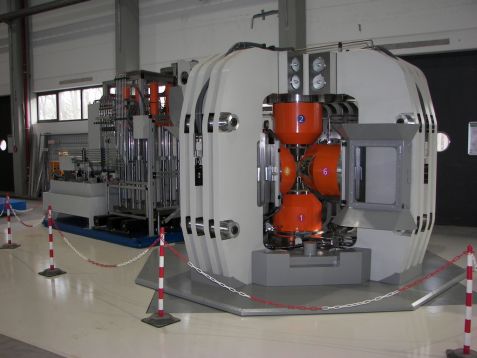MLZ is a cooperation between:
 > Technische Universität München
> Technische Universität München > Helmholtz-Zentrum Hereon
> Helmholtz-Zentrum Hereon
 > Forschungszentrum Jülich
> Forschungszentrum Jülich
MLZ is a member of:
 > LENS
> LENS > ERF-AISBL
> ERF-AISBL
MLZ on social media:

MLZ (eng)
Lichtenbergstr.1
85748 Garching
19.11.2012
The new multi anvil press goes into operation
The new multi anvil press of the Bayerisches Geoinstitut of the University of Bayreuth was delivered and put into operation in the new East Hall of the Research Neutron Source Heinz Maier-Leibnitz (FRM II). The unique high-pressure device will provide new insights into the structure of the earth’s interior and will enable the development of novel materials.

The multi anvil press of the Bayerisches Geoinstitut is mounted on its base in the East Hall of the Research Neutron Source Heinz Maier-Leibnitz (FRM II). (Walte / FRM II) © Walte/FRM II
Using neutrons, the new high pressure device for the first time allows scientists to study solids and melt under the extreme pressure and temperature conditions, such as those occurring deep within the earth. The advantage of neutrons compared to x-ray radiation is a particular sensitivity for light elements such as hydrogen, boron and carbon, which play a crucial role in the dynamics of the earth, but also in materials research for the development of new super-hard materials. Another feature of the device is the ability to deform the sample during the measurements and to measure the stresses.
In addition, the scientists expect to get fundamental new insights into the carbon cycle of the earth. Only a small fraction of the available carbon in the soil is present in the atmosphere as CO2 and affects the climate. The biggest carbon store is the mantle, and the slow exchange of carbon between the earth and the atmosphere, for example through volcanic eruptions, has over geologically long periods affected the climate on earth. Many details of this carbon cycle and the storage of carbon in the earth are not yet understood.
The multi anvil press of the Bayerisches Geoinstitut is the first of six new instruments being deployed in the new East Hall. The high pressure device is as big as a truck and weighs about 50 tons but can be aligned in the neutron beam with an accuracy of a few hundredths of millimeters horizontally and vertically and can additionally be rotated around the sample. Pressures up to 250,000 times the atmospheric pressure can be asserted on samples as small as a few millimeters and the samples can be heated up to 2000 degrees Celsius.
Further information:
Press release of the University Bayreuth
Contact:
Dr. Nicolas Walte, Bayerisches Geoinstitut/Forschungs-Neutronenquelle Heinz Maier-Leibnitz (FRM II), E-Mail: nico.walte@uni-bayreuth.de:
Press contact:
Petra Riedel, press officer, Forschungs-Neutronenquelle Heinz Maier-Leibnitz (FRM II), Tel. ++49 89 289 12141, E-Mail: presse@frm2.tum.de:
MLZ is a cooperation between:
 > Technische Universität München
> Technische Universität München > Helmholtz-Zentrum Hereon
> Helmholtz-Zentrum Hereon
 > Forschungszentrum Jülich
> Forschungszentrum Jülich
MLZ is a member of:
 > LENS
> LENS > ERF-AISBL
> ERF-AISBL
MLZ on social media:


